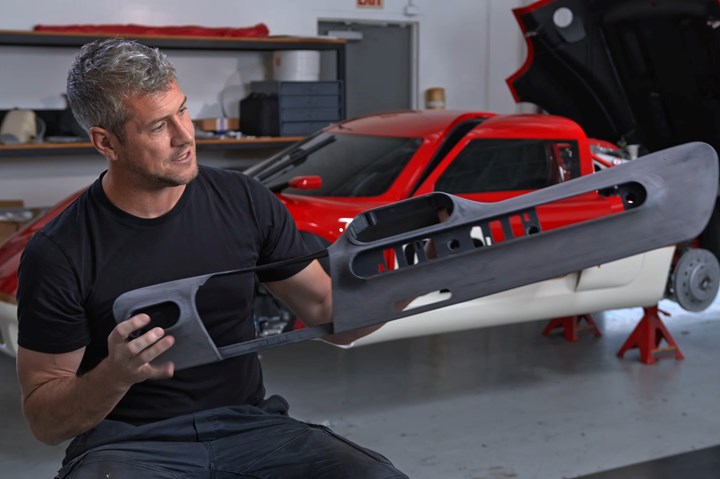Stratasys produces 500 3D-printed parts for the Lotus Type 62-2 coachbuilt sports car
Numerous 3D-printed composite mounting brackets, exterior components and a solid firewall sandwich core bring 1960s-style supercar automaking into the 21st century.

Ant Anstead shows a 3D-printed part for the Lotus Type 62-2 coachbuilt as shown in the Discovery+ documentary, Radford Returns. Photo Credit: Business Wire
Polymer 3D printing solutions company Stratasys (Rehovet, Israel and Eden Prairie, Minn., U.S.) has partnered with Radford Motors (Newport Beach, Calif., U.S.), a global luxury automotive brand, to create more than 500 3D-printed parts — including numerous composite components — for the launch of the Lotus Type 62-2 coachbuilt supercar as shown in the Discovery+ documentary, Radford Returns, that tells the story of the revival of the art of coachbuilding using 21st century technology.
“Stratasys’ 3D printing technology gave us the design freedom and ability to easily create customized, one-off pieces and parts for these two prototype vehicles. It gave us the ability to fully embrace customized coachbuilding but with updated processes using 21st century technologies,” said host Ant Anstead.
To produce the first two cars, more than 500 parts were 3D-printed at the Radford Studio, automotive design and engineering firm Aria Group (Yellow Springs, Ohio, U.S.) and Stratasys Direct Manufacturing. Using Stratasys’ GrabCAD Shop workflow software, the Radford team scheduled and tracked their 3D prints across five global locations, using a fleet of up to 20 different Stratasys 3D printers at one time. The array of Stratasys printers included the F900, F770, Fortus 450mc, F370 and J55 3D printers, each used to achieve different desired outcomes for each part.
“By integrating 3D printing technology into their shop, Radford has been able to bring 1960s-style supercar automaking into the 21st century with the high-end, hyper-customized style and features that their customers expect in a vehicle of this caliber,” says Pat Carey, senior vice president, strategic growth, for Stratasys. “It’s an extreme example of something we see every day in the auto industry. Everyone making investments in new vehicles wants a deeper level of customization and 3D printing is helping make it possible.”
By using various 3D printers and technologies, the team was able to produce parts like a large solid composite firewall sandwich core, printed in two halves on the Stratasys F900 printer in ULTEM 1010 resin. The part was bonded together into a single piece and then wrapped with carbon fiber without the use of a layup tool. The design of the firewall included complex mounting features for interior speakers, a fuel filler mount and the luggage compartment. Additionally, many exterior items like side mirror housings, radiator ducts and body vents were printed in FDM Nylon 12 carbon fiber and ASA materials. Numerous mounting brackets throughout the car were also printed in FDM Nylon 12 carbon fiber due to many factors including strength requirements, the aggressive project schedule and complete design freedom.
Stratasys will continue to support the Radford Lotus Type 62-2 project with 3D-printed production parts across the company’s various 3D printing technologies including FDM, SAF, stereolithography and P3 Programmable PhotoPolymerization.
Related Content
-
Plant tour: Teijin Carbon America Inc., Greenwood, S.C., U.S.
In 2018, Teijin broke ground on a facility that is reportedly the largest capacity carbon fiber line currently in existence. The line has been fully functional for nearly two years and has plenty of room for expansion.
-
Low-cost, efficient CFRP anisogrid lattice structures
CIRA uses patented parallel winding, dry fiber, silicone tooling and resin infusion to cut labor for lightweight, heavily loaded space applications.
-
Prepreg compression molding supports higher-rate propeller manufacturing
To meet increasing UAV market demands, Mejzlik Propellers has added a higher-rate compression molding line to its custom CFRP propeller capabilities.
















